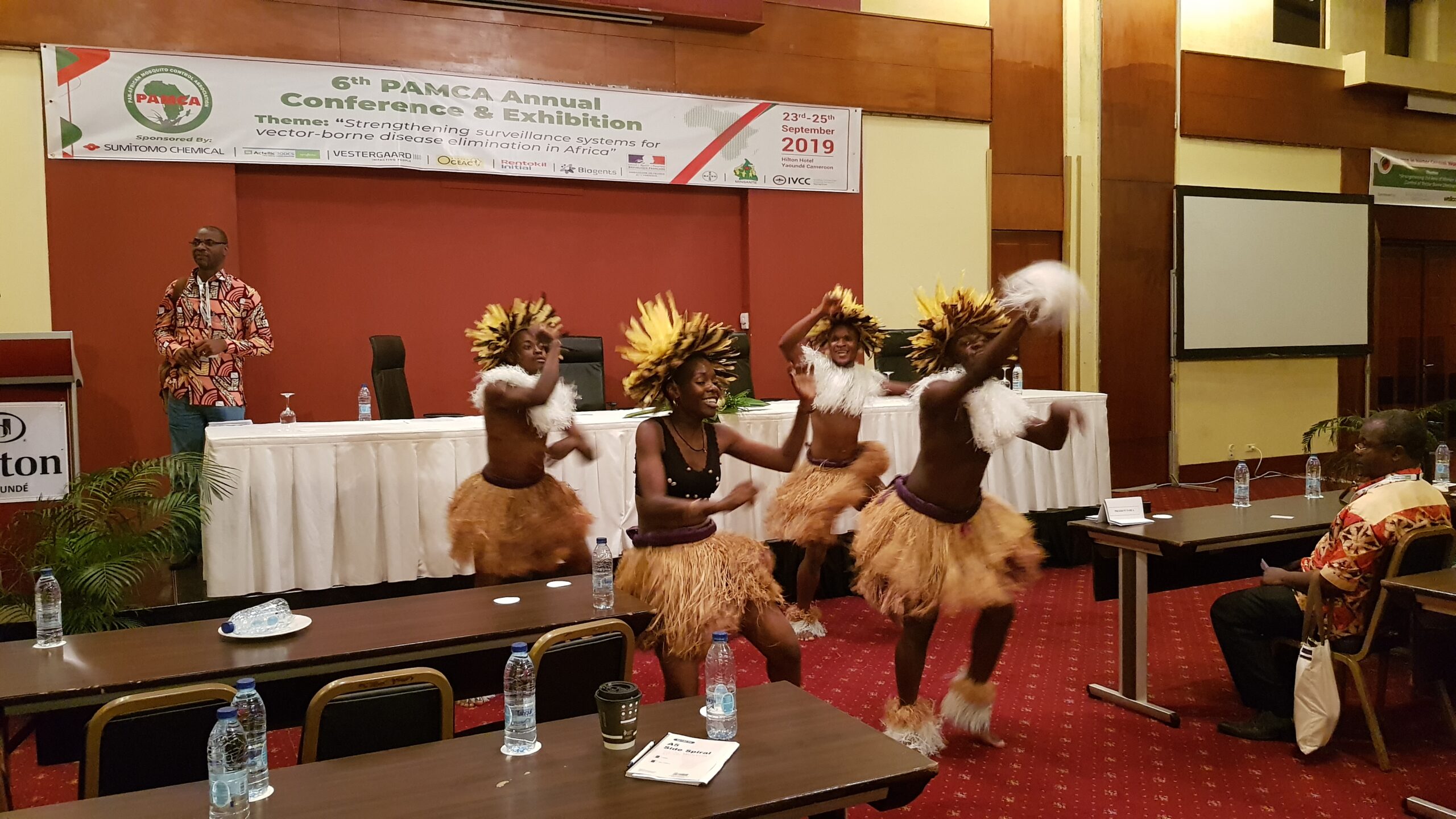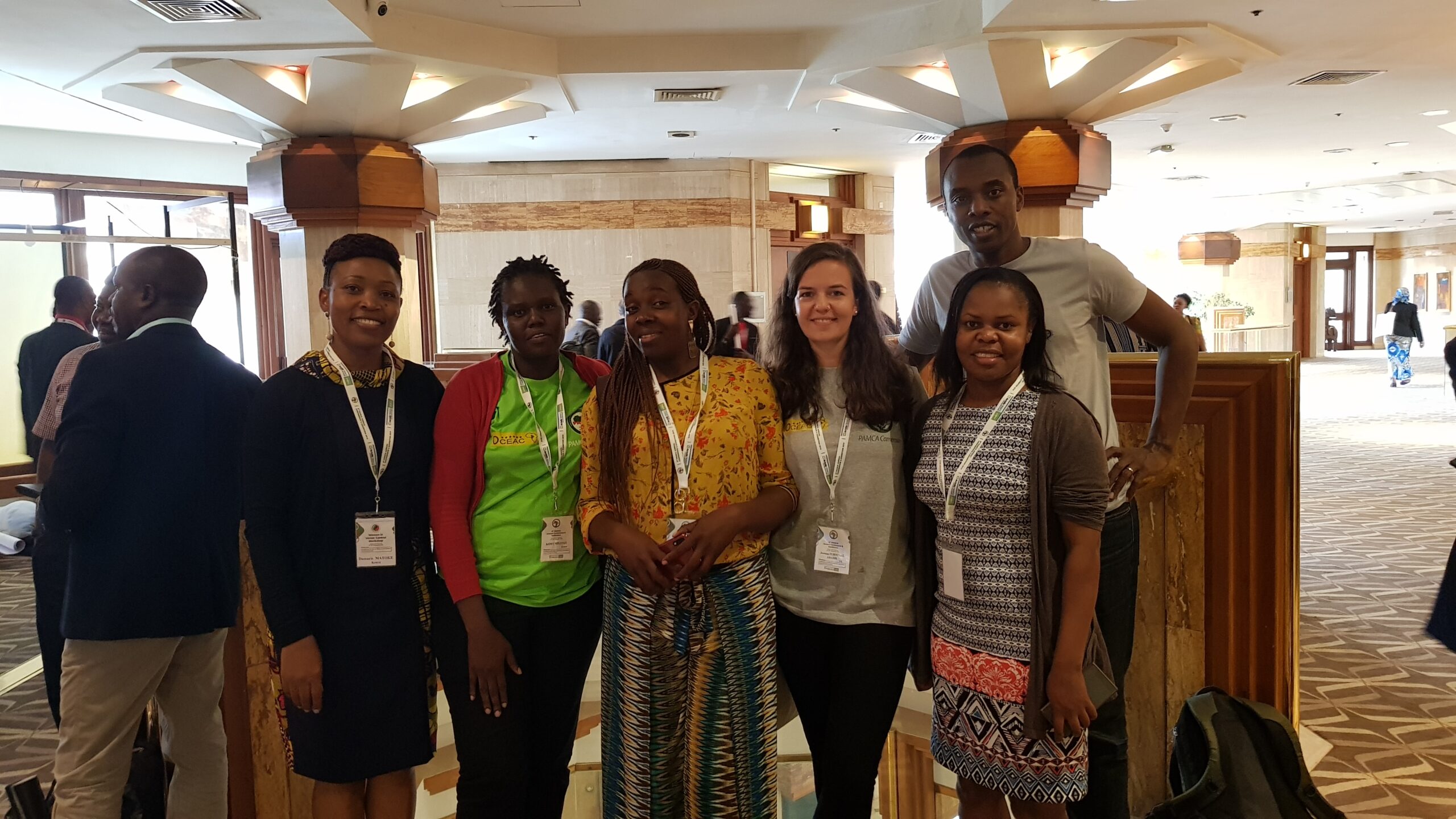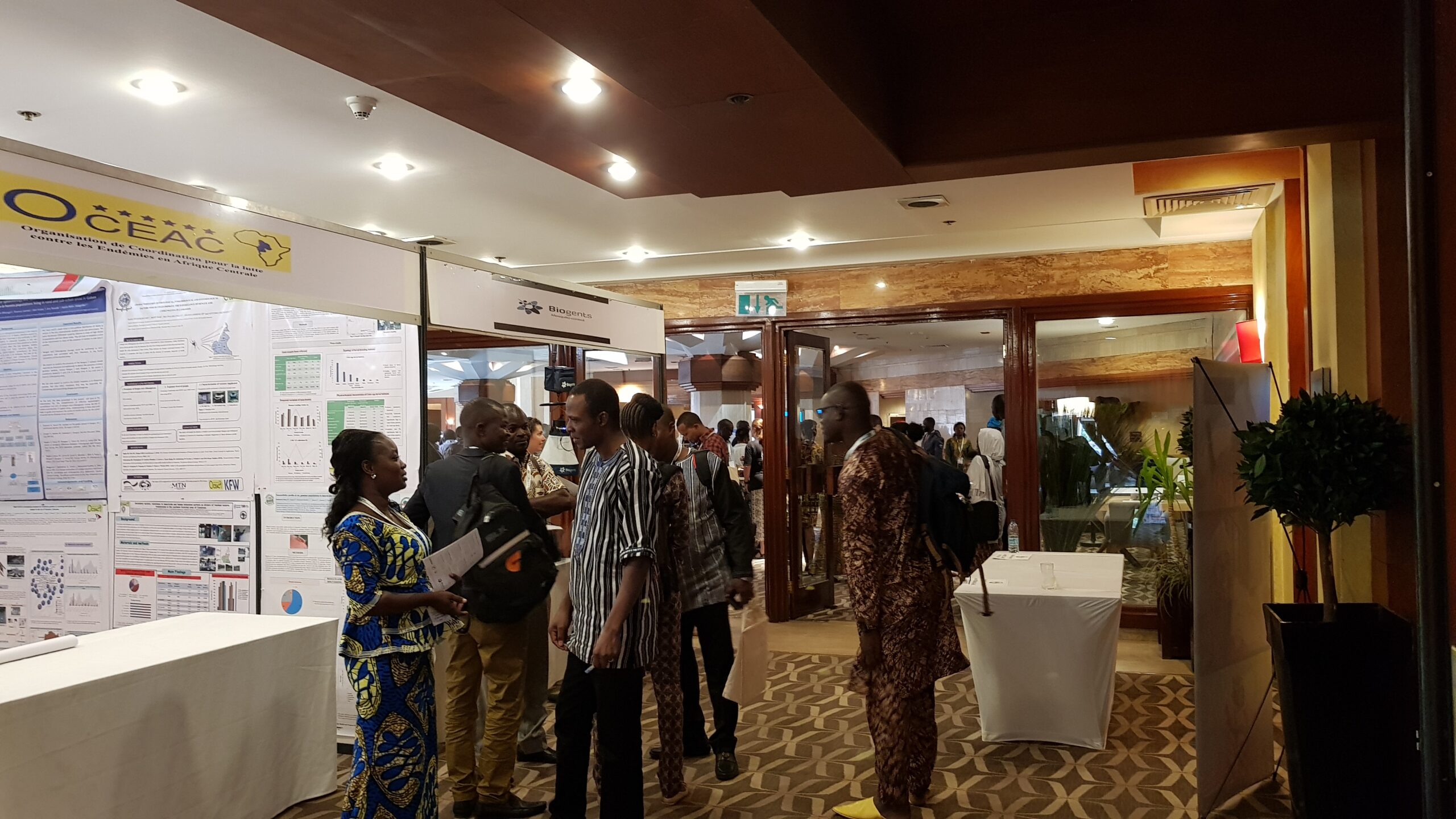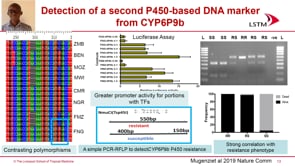6th PAMCA Annual Conference and Exhibition – 2019: Day 3
Wednesday, 25th September 2019
Published: 20/09/2019
This report is brought to you by the MESA Correspondents Nathalie Amvongo Adjia, Joanna Furnival-Adams, Teresia Njoroge, and Trizah Koyi. Senior editorial support has been facilitated by Elijah Juma and Silas Majambere.
THEMES: THEMES: Vector Control
MESA Correspondents bring you cutting-edge coverage from the 6th PAMCA Annual Conference & Exhibition
Day 3: Friday, 25th September 2019
PAMCA Symposium
Dr Silas Majambere (Director of Scientific Operations, PAMCA) spoke on behalf of PAMCA Executive Director Dr Prosper Chaki and provided an update about “PAMCA – Who we are and where we are.” Silas elaborated on PAMCA’s mission and vision; highlighted the eight registered country chapters with more than 250 active members, and presented data from a PAMCA study in 2017 on the entomological and institutional capacity in Africa. He also highlighted ongoing programmes currently being implemented by PAMCA including gene drive training, the women in vector control workshop, technical support to National Malaria Control Programmes (NMCPs) and the organization of annual meetings. The current PAMCA meeting had an attendance of 400 participants from 34 countries. Additionally, he outlined the PAMCA’s plans for the next 3-5 years, such as the strengthening of the entomology capacity in Africa, vector surveillance, strategic collaborations with both local and international bodies, development of a support system for early-career entomologists, and a renewed focus on non-malaria vectors.
Industry update
Angus Spiers (Director of Innovation to Impact, i2i) gave an update of i2i, an initiative that promotes innovation, efficiency, and quality in vector control product development. In collaboration with all the stakeholders involved in developing and bringing new vector control tools to market, i2i identifies the shared obstacles and catalyses solutions. John Lucas (Sumitomo Chemicals) presented a new award, the Innovation in Africa Award, that aims to encourage young scientists to think creatively about vector control and foster stronger relationships between industry and researchers. Justin McBeath (Bayer) discussed market-dependent factors that affect the effectiveness of indoor residual spraying (IRS). He referred to trials that examine a novel product, Fludora Fusion. Robert Vink (Syngenta) presented a video that summarized the potential impact of a novel IRS chemical, Actellic 300CS, highlighting the perspectives of community members, researchers, and industry. Justin McBeath (RBM Partnership to End Malaria) gave an update of the Vector Control Working Group (VCWG); a platform that works to improve information sharing across countries and research groups.
Symposium 6: Introduction to the PIIVec: Partnership for increasing the impact of vector control
Prof Charles Wondji (Liverpool School of Tropical Medicine, LSTM, UK and ED CRID, Cameroon) kicked off this symposium by introducing the PIIVeC as an international collaboration platform that brings together leading African research institutes and national disease control programmes to develop evidence-based solutions for integrated vector control in countries with a high burden of vector-borne diseases.
Prof Hilary Ranson (LSTM, UK) further explained the PIIVeC strategy that focuses on increasing the autonomy of institutions and facilitates knowledge translation to policy-makers. Thereafter, Prof Philip J. McCall (LSTM, UK), co-organizer of the symposium, gave the floor to the first cohort of PIIVeC African Research Career Development fellows for brief presentations about their research projects, preliminary results and the impact of PIIVeC on their careers.
Elisabeth Bandason (University of Malawi) provided projections on how disengagement influences the efficacy of vector control interventions in Malawi by studying mosquito physiology and behaviour. She also talked about her involvement in mentoring young scientists in Malawi.
Huguette Simo (CRID, Cameroon) presented the study design of a project that assesses the epidemiological risk of Chikungunya, Dengue, and Zika virus outbreaks in Cameroon. The study aims to unravel the incidence and prevalence of these diseases with the ultimate goal of supporting the national vector control programmes.
Hyacinthe Toé (National Institute of Public Health, INSP, Burkina Faso) gave a presentation about epidemiological surveillance of Aedes sp. in rural, urban and peri-urban areas of Burkina Faso. This study will benefit the country’s vector control program on surveillance and control of Aedes transmitted diseases.
Evelyn Olanga (University of Malawi) presented the experimental design and the preliminary findings of a study that estimates indoor and outdoor malaria transmission in two districts in Southern Malawi.
Moving away from diseases transmitted by mosquitoes, Lassane Koala (Institut de Recherche en Sciences de la Santé, IRSS, Burkina Faso) presented a study that aims to develop efficient traps and targets for the xenomonitoring of the population of Simulium damnosum s.l. in the southwest region of Burkina Faso. This project aims to provide information about effective surveillance of black flies that cause river blindness disease.
On the same line, Tito T. Melachio (CRID, Cameroon) talked about the microgeographic structure, vector control and population dynamics of Glossina palpalis palpalis and its impact on human and animal trypanosomiases in southern Cameroon. The study involves monitoring and surveillance of tsetse flies and assesses insecticide resistance development. The study will contribute to the elimination of sleeping sickness in Cameroon.
Jessica Amegee (LSTM, UK) gave a presentation about the contribution that PIIVeC makes in strengthening institutional capacity to conduct vector control research. She highlighted some of the common challenges that partner institutions face and the priority actions that PIIVeC takes to strengthen these institutions.
Chikondi Mwendera (LSTM, UK) outlined the role of PIIVeC in the establishment of technical vector control advisory groups (TVCAGs). The mandate of these TVCAGs is to advise in-country programmes on vector control. He also presented experiences and opportunities of the TVCAGs from pilot countries.

Parallel session 6: Innovation in vector surveillance and control
Givemore Munhenga (University of Witwatersrand, South Africa) discussed mosquito surveillance in South Africa over a 5-year period that took place in preparation for a pilot sterile insect technique (SIT) intervention. The data will be used to predict how sterile males may disperse in a SIT release, and to select the appropriate field site.
The talk by Michelle Stanton (Lancaster University, UK) focused on the use of drones to identify Anopheles mosquito breeding sites. Knowledge of mosquito breeding sites is essential for identifying malaria transmission hotspots for targeted control. The “Maladrone study” is being carried out in Malawi and involves the use of quadcopter and fixed-wing drones.
Emmanuel N’dille (Centre for Research in Infectious Diseases, CRID, Cameroon) presented results from a study that indicates that expression of D7 salivary gland genes facilitate bloodmeal intake by mosquitoes. His study showed that pyrethroid resistance can influence bloodmeal intake in Anopheles funestus s.s, but not An. gambiae through overexpression of D7. Future studies will attempt to establish the potential impact on vectorial capacity.
Francesco Baldini (University of Glasgow, UK) delivered a talk on the use of Mid-Infrared Spectroscopy (MIRS) to predict mosquito traits such as age and species. The technology is based on mosquito cuticle composition and has the potential to significantly improve vector surveillance programmes.
Antoine Sanou (Centre Nationale de Formation et Recherche sur le Paludisme, Burkina Faso and University of Glasgow, UK) talked about biting and resting behaviours of malaria vectors in rural Burkina Faso following the scale-up of long-lasting insecticidal nets (LLINs). Results showed a long-term reduction in abundance but no evidence of long-term changes in biting behaviour.
Parallel session 7: Vector biology and control
Badolo Athanase (Université Joseph Ki-Zerbo, Burkina Faso) gave a presentation about a study of the bionomic variations and genetic diversity of Aedes aegypti populations from Burkina Faso. He characterized genotypic traits associated with resistance and recorded high pyrethroid resistance. He suggested that further genome sequencing research is needed to provide a clear image of Ae. aegypti bionomic and genetic links.
Basile Kamgang (CRID, Cameroon) presented findings of a study that confirmed the potential of Aedes albopictus and Aedes aegypti to transmit yellow fever in urban areas of Central Africa. Kamgang recommended collective efforts in vector surveillance. He called upon the public health authorities to intensify their efforts to control the domestic vectors and extend vaccine coverage to prevent major yellow fever outbreaks in future.
Parallel session 8: Vector biology and control
Dr Jennifer Stevenson (Macha Research Trust, Zambia and John Hopkins Bloomberg School of Public Health, USA) described outdoor malaria vectors in low and high transmission settings in Zambia. She highlighted the importance of outdoor sampling for surveillance; sampling at the right time when humans are present; and the inclusion of all mosquitoes to establish species composition.
Edmond Kopya (OCEAC and University of Yaounde 1, Cameroon) provided a broad overview of An. funestus research followed by a detailed presentation of results showing the impact of glutathione S-transferase (GST) resistance on An. funestus vector competence.
Prof Josiane Etang (OCEAC and University of Douala, Cameroon) talked about the insecticide resistance status and the underlying mechanisms governing deltamethrin resistance in Anopheles gambiae in Northern Cameroon. She collected mosquito larvae from 24 sites between 2011 and 2015. Because her research confirmed increased resistance of deltamethrin in An. gambiae, improved vector surveillance and insecticide resistance management strategies are urgently needed in Cameroon.
Olukayode G. Odufuwa (Ifakara Health Institute, IHI, Tanzania) presented on behalf of Sarah Moore (IHI) and talked about insecticide-treated net (ITN) evaluation in experimental huts vs. the Ifakara Ambient Chamber Test (I-ACT). Results showed that the I-ACT assay can be used to measure small effect differences between new products.
Booster talk: My thesis in 3 minutes
The final session of the PAMCA 2019 conference was a series of booster talks chaired by Prof Flobert Njiokou (University of Yaoundé 1, Cameroon). During this session, six Ph.D. students took the challenge to present their research activities in 3 minutes. This exercise featured talks on push-pull control strategies against mosquitoes, insecticide resistance status, genes and fitness cost on males’ mating competitiveness, Anopheles life traits and vector competence, and the entomological risk of arbovirus outbreaks. Amelie Wamba (University of Yaoundé 1 and CRID, Cameroon) emerged as the winning student and was awarded the prize of the “Best presenter” by a multi-country jury panel.
Closing Ceremony
The closing ceremony began with invigorating music and dance performance by students from the University of Yaoundé I. This was followed by a brief talk by Dr Antonio-Nkondjio (President of the Local Organizing Committee, Cameroon) who captured the synopsis of the pre-conference activities and the main conference. Overall the conference attracted over 400 participants and featured over 250 presentations in the form of keynote speeches, oral presentations, and poster presentations. He expressed his gratitude to keynote speaker, Prof Charles Wondji, the plenary speakers, and members of the secretariat. PAMCA president, Prof Charles Mbogo oversaw the presentation of awards to best booster presentations, best poster presentations, and gave the closing speech marking the end of the 3-day PAMCA conference in Yaoundé, Cameroon. The musicians and dancers yet again lit up the room and encouraged delegates to join them to mark the close of the conference.
Poster presentations
The poster presentations are covered in the abstract book pp. 128-336

This report is brought to you by the MESA Correspondents Nathalie Amvongo Adija (Institute of Medical Research and Medicinal Plants Studies, Cameroon), Joanna Furnival-Adams (Liverpool School of Tropical Medicine, UK), Trizah Koyi (International Centre of Insect Physiology and Ecology, Kenya) and Teresia Njoroge (University of Illinois at Urbana-Champaign, USA) with mentoring and editorial support from MESA and MalariaWorld. Senior editorial support has been facilitated by Elijah Juma & Silas Majambere from PAMCA. This report is cross-posted on the MESA Website and on MalariaWorld.
Published: 20/09/2019
This report is brought to you by the MESA Correspondents Nathalie Amvongo Adjia, Joanna Furnival-Adams, Teresia Njoroge, and Trizah Koyi. Senior editorial support has been facilitated by Elijah Juma and Silas Majambere.
THEMES: Vector Control

